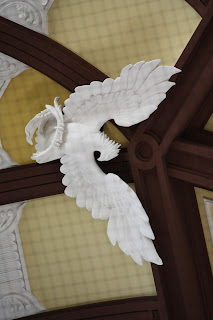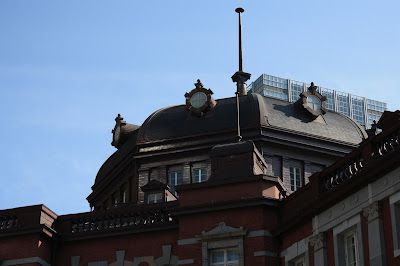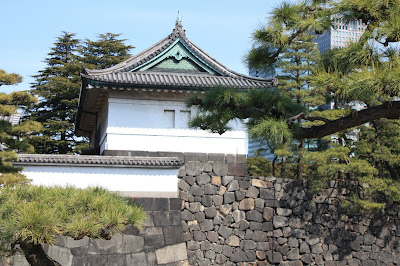If you followed this blog when I first started it (2008), or have read posts from then, you know that I spent a year as an ALT (Assistant Language Teacher) in Japan. I worked at a junior high school, and there were three Japanese English teachers there. I called her "Sensei" while I worked with her and still do. My year at the school was successful, to the extent that it was, largely due to her help. I've kept in touch with her, and on Saturday, I was able to meet up with her again. I prefer to err on the side of caution when dealing with others' privacy, so I'll call her "Sensei" here as well.
She has since married, and her husband also came along. I will call him "Mr. Sensei", since he has taken her family name. This is not unusual in Japan in the case of a woman with no brothers to carry on the name. Often, her family will formally adopt the new husband as a son. This is why many of the world's oldest companies are Japanese -- if there was no heir, or the heir was inadequate, the family that owned the company adopted an outsider to be the heir. He also often married one of the daughters. This happened in the ruling class as well during feudal times.
I took the shinkansen to Tokyo Station Saturday morning. I left Okazaki Station at 5:45 and took a train to Toyohashi. From there, the shinkansen left at 6:40 and arrived at Tokyo Station at 8:13. Not too shabby, right?
I love Tokyo Station. I love Frank Lloyd Wright's work, and I'm normally not into lots of decorative fiddly bits, but Tokyo Station -- the Marunouchi side, anyway -- is my favorite building.
Construction began on Tokyo Station in 1908 and completed in 1914. This original station included only the current Marunouchi side. The Yaesu side was added later. The station was mostly destroyed in WWII. Reconstruction only included two stories of the original three, and other features were not included.
Here is a picture of the rather boring Yaesu side, from Wikipedia.
(By Tyoron2 - Tyoron2's file, CC BY-SA 3.0, https://commons.wikimedia.org/w/index.php?curid=4306554)
At the time that I was living in Tochigi (three hours from Tokyo by train), the reconstruction was being redone to recreate the beautiful original station. So, of course, I was eager to see it.
But, there is always construction, isn't there? Currently, the station is having work done to make it more earthquake proof. All of this will be hidden from view -- a platform is being built under the station, so when an earthquake occurs, the platform will move and the building will sway, but not collapse. Remember, in Japan it's always when and earthquake occurs, not if.
Begin Japanology has an episode devoted to Tokyo Station, if you'd like to learn more. I recommend the NHK's Begin Japanology videos to anyone interested in Japan. There are a small ton of them on YouTube.
Here are pictures from inside the domes.
And here are pictures of the outside:
After admiring the new reconstruction and taking pictures, I was greeted by Sensei and Mr. Sensei.
Tokyo Station is very close to grounds of the Imperial Palace. The grounds are huge, with lots of space available to the public, like a park in the middle of Tokyo. We had a nice stroke of luck -- admission to the gardens was free that day! Nice.
We strolled through the garden area.
The city is right there, though.
And there are castle bits.
Here's how large the stones are -- with people for comparison.
And some random flowers. They might be cherry blossoms.
Then we came across the base for a tower for Tokyo Castle. By the time that the base was built, Japan had be unified and there was peace in the country, so it was decided that it was not necessary to build the rest of the tower.
More of the tower base.
Again, people for scale.
A magnolia!
Another flower.
Here are university graduates going to their graduation at Budokan. If you're my age, you'll remember Cheap Trick's "Live at Budokan" album. Same place. The school year in Japan runs April through March. Remember that, if you ever want to become an ALT!
The women are wearing hakama, which was the women's student uniform in the Meiji era. Sensei wore hakama to our 3rd year students' graduation and I thought it looked so cool. The footwear that goes with this outfit are lace-up ankle boots, not the geta or zori (they look like super dressy flip-flops) that are usually worn with kimono.
After that, we went to Yasukuni Shrine in hopes of seeing some early cherry blossoms. There is controversy surrounding Yasukuni Shrine. The shrine is devoted to all who died in any war fought in by the Japanese. The shrine's kami, or deities, are the spirits of these war dead. The controversy is due to the fact that some of those enshrined here are Class A war criminals from WWII. You may have seen the kerfuffle that occurs when an Japanese politician visits Yasukuni Shrine and objections are raised by China, Korea or both. Also, some of the enshrined were Koreans who were killed while being forced to work in military industries in Japan in WWII. In these cases, they were automatically enshrined without consultations with their families.
The "on the other hand" view is that Yasukuni Shrine is Japan's equivalent of Arlington Cemetery, and war dead are war dead.
As it was, the cherry trees weren't ready. So, we prayed at the shrine and left. My prayer was that nobody else would qualify to be enshrined here.
Lunch was a little restaurant that we stumbled upon. I had udon (like ramen but with thick noodles) and a dish of pork and egg on rice. The beer that Mr. Sensei and I shared paired with dinner perfectly! Yum!
Our next stop was the Yamatane Art Museum. This museum has a very good collection of Nihonga paintings, and I've wanted to see it since I found out about it -- after I'd left Japan the last time, of course.
The museum is near Shibuya and Ebisu stations, and you can view their exhibits here. Googleartproject has lots of partner institutions, so go find the art you like!
We enjoyed the exhibit, then sweets and tea in the cafe.
After that, we went to Ginza, near Yurakucho station. Our goal? Itoya! Itoya is a large and famous stationary store. They are also the supplier of Japanese good to a local pen shop in Wisconsin.
They have a whole floor of fountain pens, including many with lacquer bodies, and maki-e designs on them. These are out of my reach, budget wise, but they are truly works of art. As an example, here is one from Pilot/Namiki, that I hope to own someday.
After that, we returned to Tokyo Station. The Sensei's returned to Tochigi, and I waited around for a night bus back to Okazaki. Night buses offer the benefit of cheap travel, and no need for a hotel. They do not offer the best sleeping experience. My bus left Tokyo at 11 pm, and arrived at Okazaki Station at 5 am the next day.
As a reference, a reserved seat from Okazaki to Tokyo on the Kodama Shinkansen cost me Y9480. It was comfy, and fast. It was crowded, even in the reserved cars, so I'm glad I didn't get an unreserved seat for Y500 less.
The night bus cost Y6300, and all seats are reserved and the bus was full. If anything, I recommend getting your ticket early enough to select a window seat so you have something to lean against. I was in the middle, so it was harder to sleep. I took a JR bus, and bought my ticket online, in English, using a debit card. There are lots of night bus routes offered by several different companies. This bus had a toilet, and an electric outlet for each seat. There was one stop at a wayside on the way.

























































No comments:
Post a Comment